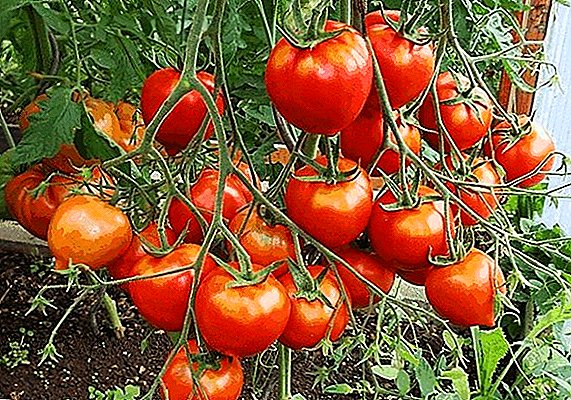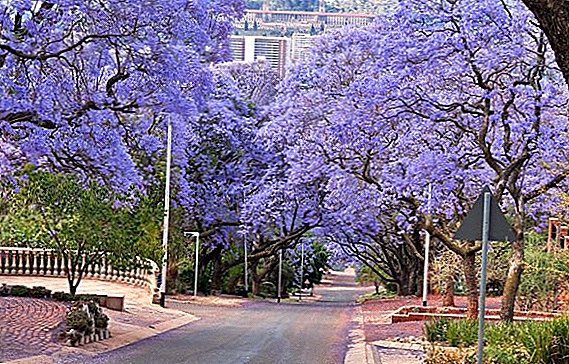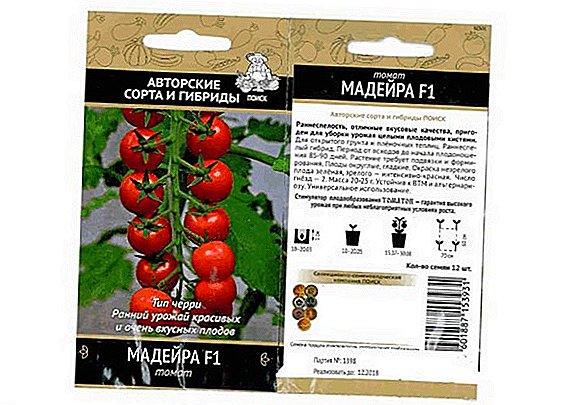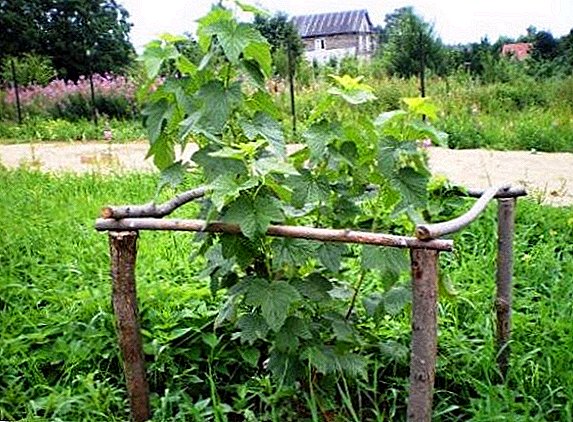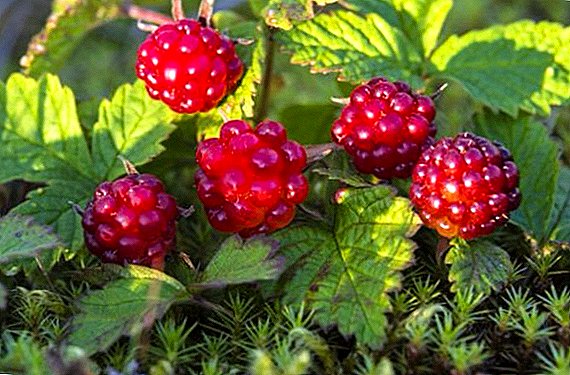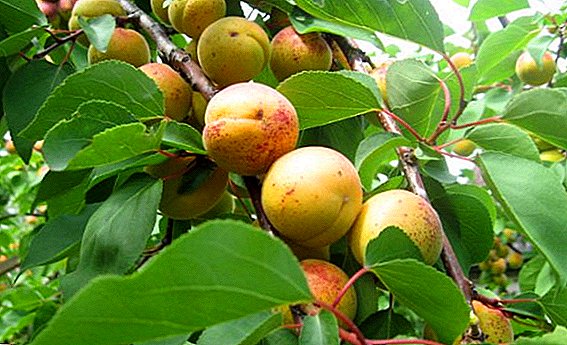 With the arrival of summer, fresh local vegetables and fruits appear on the shelves of shops and markets. And among this variety, one of the most visible and beloved is apricot. This bright and sweet fruit is very popular, loved by both adults and children. But with his closest relative - a longing - as a rule, they know much less. Let's find out what is a fruit, how it is useful for the body, and how to use it.
With the arrival of summer, fresh local vegetables and fruits appear on the shelves of shops and markets. And among this variety, one of the most visible and beloved is apricot. This bright and sweet fruit is very popular, loved by both adults and children. But with his closest relative - a longing - as a rule, they know much less. Let's find out what is a fruit, how it is useful for the body, and how to use it.
Botanical description
Zherdela is a wild apricot belonging to the genus Plum and grows in many countries with a warm climate. The tree reaches a height of 15-17 meters and is characterized by a thick crown, blooming with white or pink flowers. By the way, the color on the tree appears earlier than the leaves.  Fruit zherdely very similar to the cultivated apricot - yellow, orange, sometimes interspersed with red, color, with a soft fleecy surface, flesh with palpable fibers and a flat bone. The taste also differs little from the cultural apricot, although often there is a little tartness and bitterness.
Fruit zherdely very similar to the cultivated apricot - yellow, orange, sometimes interspersed with red, color, with a soft fleecy surface, flesh with palpable fibers and a flat bone. The taste also differs little from the cultural apricot, although often there is a little tartness and bitterness.
We advise you to read about the beneficial properties of apricot and other plum crops: plum, cherry plum, peach (dried), nectarine, cherry.
Chemical composition
There is a rich palette of various vitamins in the fruit of the cradle.
One hundred grams of fresh fruit contains:
- Vitamin A - 0.267 mg;
- Vitamin B1 - 0.03 mg;
- vitamin B2 - 0.06 mg;
- Vitamin B3 - 0.7 mg;
- Vitamin B4 - 1 mg;
- Vitamin B5 - 0.3 mg;
- Vitamin B6 - 0.05 mg;
- Vitamin B9 - 0.003 mg;
- Vitamin C - 10 mg;
- vitamin E - 1.1 mg;
- vitamin H - 0.3 mcg;
- vitamin PP - 0.8 mg;
- beta carotene - 1.6 mg.
Important! Wild apricot, in contrast to the cultivated, has good frost resistance and disease resistance, as well as higher yields, and its taste is practically not inferior to the varietal fruit.
Macro and trace elements per hundred grams of fresh fruit:
- aluminum - 364 mcg;
- boron - 125 mcg;
- vanadium - 25 mcg;
- fluorine - 11 mcg;
- Nickel - 8 µg;
- molybdenum - 8 mcg;
- cobalt - 2 mcg;
- iodine - 1 µg;
- potassium - 305 mg;
- calcium - 28 mg;
- phosphorus - 26 mg;
- magnesium - 8 mg;
- sulfur - 6 mg;
- silicon - 5 mg;
- sodium, 3 mg;
- chlorine - 1 mg;
- iron 0.7 mg;
- manganese - 0.22 mg;
- copper - 0.14 mg;
- Zinc - 0.082 mg.

Calorie content
The calorie content of this fruit is 46 kcal per hundred grams.
Its nutritional value is:
- carbohydrates - 10 grams;
- proteins - 0.9 grams;
- fats - 0.2 grams;
- dietary fiber - 2.1 grams;
- ash substances - 0.7 grams;
- water - 86.1 grams.
Read also about the beneficial properties and options for using fruits of cherry, raspberry (black), strawberry, gooseberry, currant (red, white, black), sea buckthorn, cloudberry, cowberry, cranberry, princess, yoshta, goji, mulberry, chokeberry.
Beneficial features
Due to its composition, the controversy has a positive effect on the human body. This fruit is recommended to use when hypovitaminosis, anemia and high blood pressure. It will help activate metabolic processes in the body, and fiber will help relieve constipation. The high content of iron and calcium suggests that this fetus is useful for pregnant and lactating. Zherdela has a positive effect on function. thyroid gland and relieves fatigue.
Eating fresh fruit helps to remove overheating in hot weather and quench your thirst. A carotene, which is part of them, protects the skin from ultraviolet radiation, so the fruit is used as a lotion for sunburn. Due to the high content of potassium, the sacrifice helps the cardiovascular system, cleanses the body of toxins and removes excess fluid from soft tissues.  The decoction of the leaves of this tree helps to increase resistance to external toxic effects, therefore, it is extremely useful for those who often come into contact with harmful substances.
The decoction of the leaves of this tree helps to increase resistance to external toxic effects, therefore, it is extremely useful for those who often come into contact with harmful substances.
Important! If you are a big fan of apricot kernels, then please note that you shouldn’t use the stones of a lambda. These nucleoli not only have an unpleasant bitter taste, they can lead to hydrocyanic poisoning.
Use in cooking
Zherdela is used in various recipes almost the same as apricot. Most often it can be found as stuffing in pies, pies and other pastries. From zherdely make beautiful juices, compotes and jelly. The fruit is very good at home canning, it turns out delicious jam and jam.
The fruit is eaten in a different form - fresh, dried, dried and smoked. They make exquisite sauces for meat and even cook soups. And fans of non-standard alcoholic drinks manage to make wine, brandy and homemade vodka out of it. 
Harmful properties
Sometimes there is a toaddle allergic reactionexpressed in reddening of the skin, abdominal pain, diarrhea, sore throat and headache. In this case, you must take an antihistamine and go to a medical facility.
Overeating this fruit can also provoke an upset stomach. Therefore, you should not lean on one product, food should be varied and balanced.
Learn how fruit have beneficial properties for the body: pear, apples, quince, tangerines, lemons.
Contraindications
Fruits of a zherdela, as well as many other fruits, are contraindicated to the people suffering diabetes mellitus. Do not eat them and those who have increased acidity of gastric juice. And of course, they should be used with great caution in obesity and a pronounced tendency to gain weight.
What is the difference between poppy and apricot
The poach and apricot are very similar to each other and it is often not so easy to distinguish between them. Therefore, you should pay attention to next moments:
- a brothel, as a rule, is smaller in size than its domesticated relative;
- wild apricot is usually less sweet, moreover, there is often a slight bitterness or astringency;
- the fruit of the crater is less juicy, more fibrous, the stone is more difficult to separate from the pulp.

How to choose a fruit when buying
When buying a zherdela should pay attention to the absence of dents, dark spots, rot and other damage to the surface. Fruits should not be too hard, as this suggests that they were torn off immature. But do not take too soft fruits, they may be unsuitable for food.
A ripe fruit should be well pressed, but without further deformation. It should be evenly colored and have a pleasant aroma. However, too "beautiful" fruits are also suspicious, since there is a possibility that they exceed the normal content of nitrates and other chemical additives.
Storage conditions
A carpentry, like a cultured apricot, has a rather delicate texture and can be damaged during transport and storage. Therefore, be careful with this fruit, place it in drawers in one layer and store in a cool place. Just do not count on long storage, even perfect specimens in a refrigerator (about zero degrees Celsius) will not last longer than a month.
Therefore, in order for this wonderful fruit to delight you throughout the year, it is worthwhile to do it. drying or canning. All the more so since the zherdela perfectly retains its taste and useful qualities with these methods of preparation.
Read also about the beneficial properties and application of exotic fruits: kumquat, dates, figs, litchi, papaya, arbutus, feijoa, medlar, longan, guava, kivano, pineapple, suite.
Recipes
Zherdela is perfect for recipes, because it has not only excellent taste and aroma, but also an attractive bright appearance. Perhaps that is why it is so loved by both adults and children.
Jam
Zherdela differs extraordinary aroma and a pronounced taste of honey, so it is perfect for jam.  Jam "Five minutes".
Jam "Five minutes".
Ingredients:
- one kilogram of fruit without stones;
- one kilogram of sugar;
- 0.5 teaspoon citric acid.
- Wash the fruits thoroughly and remove the bones from them, cutting them into two halves.
- Lay the crater in a saucepan, cover with sugar, cover and shake well.
- Without waiting for the fruit to start the juice, add one glass of pure water to the pan and put on a slow fire.
- After boiling, remove the foam and leave to boil for about five minutes.
- Remove from heat, wait until cool.
- Prepare jars and lids, wash and sterilize them.
- Return the jam to a small fire, after boiling add citric acid and mix everything carefully.
- Arrange the jam in containers and immediately roll them up.
- Place the jars under a warm blanket, turning them upside down.
- Cool containers to store closet.
Did you know? Wild apricot wood is known for its excellent acoustical properties, so it is used to make soundboards for musical instruments. The tree itself is quite resistant, able to endure both drought and short-term severe frosts, and bears fruit for about a hundred years.
Zherdela jam with almonds.
Almonds are surprisingly harmoniously combined with the taste of a cracker, so this jam can definitely become your favorite.  Ingredients:
Ingredients:
- one kilogram of fruit;
- about 100 grams of almond (by the number of fruits);
- one kilogram of sugar;
- 0.5 liters of clean water.
Step-by-step recipe:
- Wash the fruits thoroughly and remove the bones from them, squeezing them out with a stick.
- Pour boiling water over almonds and after peeling off the water, remove the skin from it.
- Stuff the fruit with almonds.
- Boil the syrup, pour water into the pot and add all the sugar.
- After the sugar has dissolved, carefully, one at a time, move all the fruit into the boiling syrup.
- Boil all minutes 5-7 on low heat.
- Remove the pan from the heat, cover and wait for it to cool completely.
- Prepare jars and lids, wash and sterilize them.
- Put the jam on a small fire, bring it to a boil and boil for five minutes.
- Check the syrup density by dropping it on the plate, and the syrup should not spread much.
- If the syrup is not ready, repeat the steps with boiling and cooling.
- Ready jam very gently lay a ladle on the banks and immediately roll them up.
- Place jars under a warm blanket, do not turn over, so as not to damage the fruit.
- Cooled containers with ready jam to send to storage.
Important! Try not to digest the jam, otherwise the nuts will fall out of the vents, and the fruits will boil out.
Properly cooked jam will stand without problems at room temperature for about a year. And in a cool cellar or basement, and even longer.
Jam
Since a poppy is a rather tender product that easily rumples and loses its shape during heat treatment, many housewives prefer to make jam instead of it. Moreover, the taste qualities of the gutter remain at the same high level.  Ingredients:
Ingredients:
- 1 kilogram of zherdela;
- 1 kilogram of granulated sugar.
Step-by-step recipe:
- Wash fruits thoroughly, cut off damaged areas, remove bones.
- Fold the vents in the pan and mix with the sugar.
- Boil over low heat, stirring occasionally, until the mass thickens.
- Arrange the jam in pre-sterilized containers and roll them up.
- Place the jars under a warm blanket, turning them upside down.
- Cooled containers with ready-made jam can be sent to storage.
Tip: to add sourness, you can add a few currant berries or a bit of citric acid in the jam.
Did you know? One of the proofs of the goodness of the pope is the tribe living between Pakistan and India, which, despite the poverty of the diet, is distinguished by its longevity. Vzherdela - the main product of their food, it is used in large quantities and in different forms.
Sauce
From this fruit you can make interesting sauces, well suited to meat or poultry.  Simple sauce
Simple sauce
Ingredients:
- 0.5 kg mashed potatoes;
- tablespoon of granulated sugar;
- a teaspoon of salt;
- 3 medium cloves of garlic;
- 1/3 chili pepper.
To prepare the mashed potatoes, the fruit of the zherdela is placed in boiling water, boiled for two minutes, after which the bones are separated and crushed into mashed potatoes. Then add sugar, salt, chopped chili pepper, crushed garlic, a little dill and boil for another 15 minutes. The resulting mass is crushed in a blender, brought to a boil and spread on pre-sterilized containers.
Spicy sauce
Ingredients:
- 0.5 kg mashed potatoes;
- 1.5 tsp salt;
- 1 dessert spoon of vinegar;
- 1/3 teaspoon black pepper;
- 3 cloves of garlic;
- 1 medium onion;
- 1 medium Bulgarian pepper.
Puree mashed potatoes 15 minutes boil over low heat, then add salt, vinegar, chopped black pepper, crushed garlic, finely chopped Bulgarian pepper and onions. It is still boiled for a couple of minutes, then ground in a blender, brought to a boil and laid out in pre-sterilized containers.  You can add some lemon juice, grated ginger and ground coriander to make the sauce spicy.
You can add some lemon juice, grated ginger and ground coriander to make the sauce spicy.
Soup
Zherdela is so versatile fruit that even a soup can be made from it.
Ingredients:
- 0.5 kilogram of fruit;
- 700 grams of milk;
- 2 tablespoons of starch;
- 1 egg yolk;
- several almond nuts;
- salt, sugar, butter.
To prepare it is better to take not very sweet fruit. To begin with, starch is added to the milk and brought to a boil. Fruit puree is mixed with milk, again brought to a boil, add almonds, salt and sugar and whisk everything in a blender. Remove the pan from the heat and add the egg yolk. Before serving, put a small piece of butter in the plate. Enjoy your meal!
Now you know how many delicious dishes can be cooked from zherdela, and how much benefit this solar fruit will bring to your body. Do not forget to include it in your diet and be healthy!


